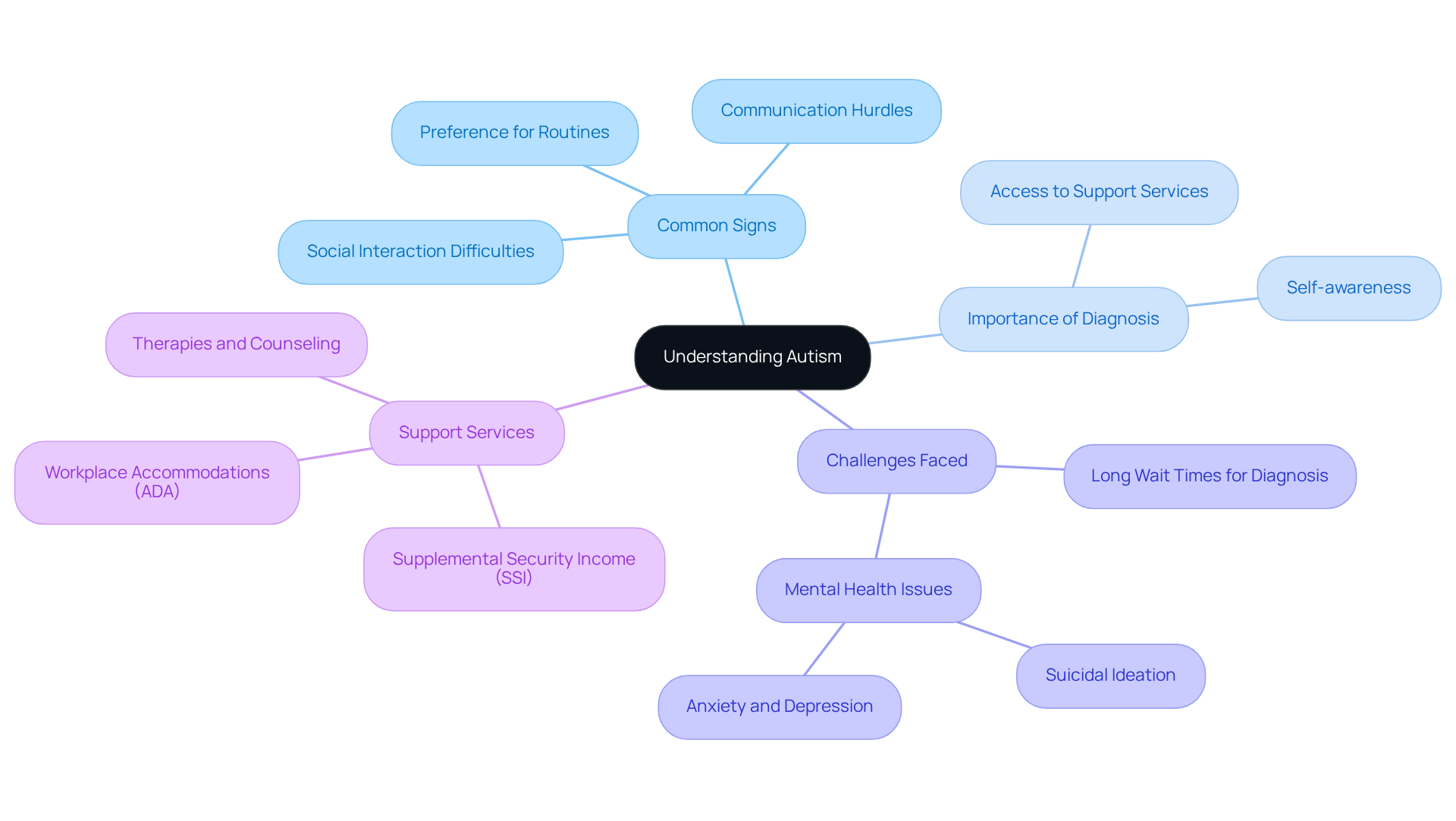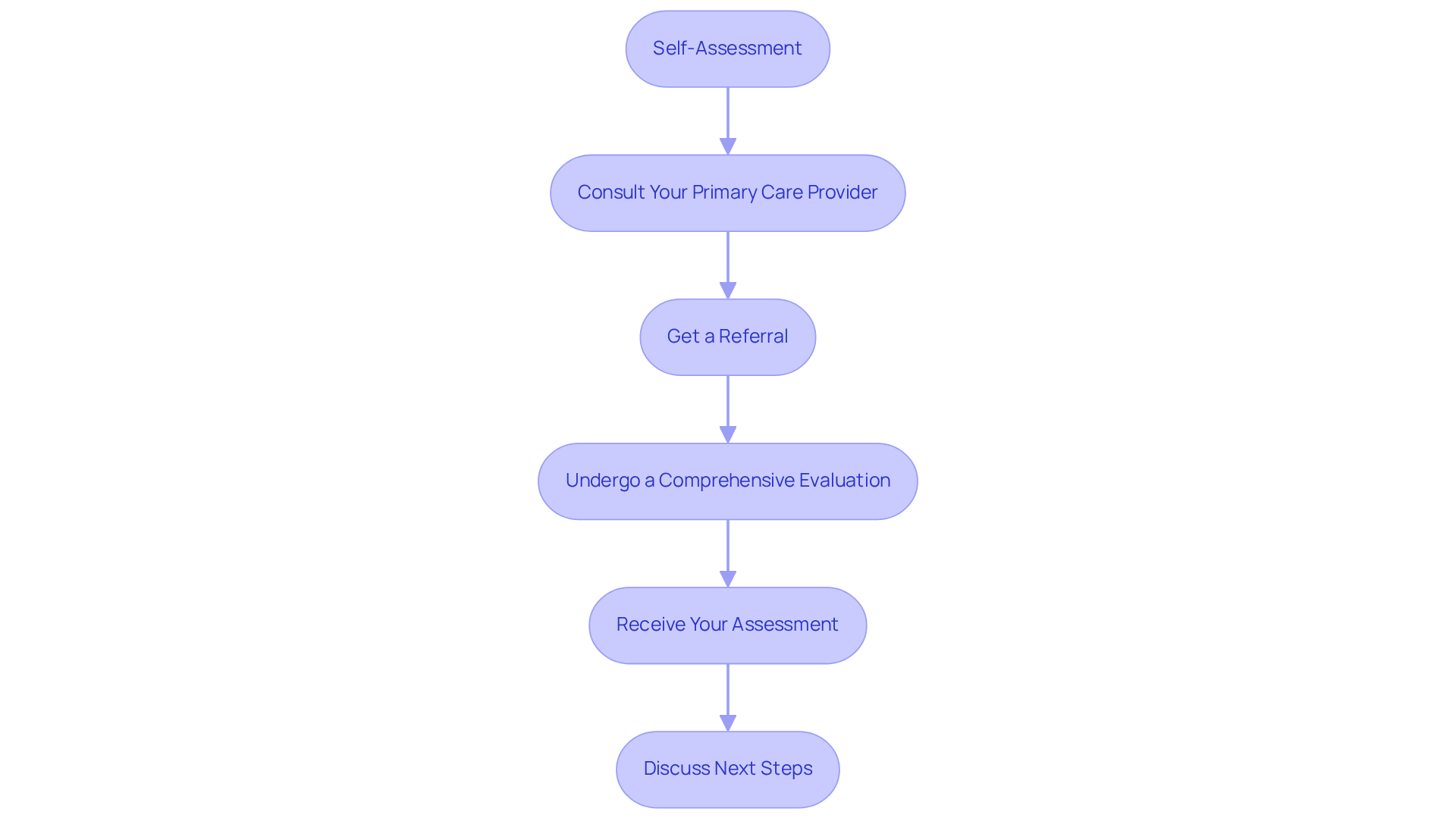Overview
This article presents a compassionate step-by-step guide for adults who are considering a diagnosis for Autism Spectrum Disorder (ASD). It highlights the significance of:
- Self-assessment
- Consulting with healthcare professionals
- Being aware of available resources
By detailing each step—from initial self-reflection to receiving a formal diagnosis and accessing support services—it illustrates how a diagnosis can positively impact individuals' lives and overall well-being. Understanding this journey can be transformative, and we encourage you to explore the resources available to support you along the way.
Introduction
Understanding Autism Spectrum Disorder (ASD) is essential for many adults who navigate the complexities of social interactions, face communication hurdles, and seek the comfort of routine. The journey toward diagnosis can be a transformative experience, offering valuable insights that enhance self-awareness and open doors to vital support services. Yet, the path to obtaining a formal diagnosis can often feel daunting—what steps can individuals take to ensure they receive the appropriate evaluation and support? This guide aims to provide a compassionate roadmap for navigating the autism diagnosis process, empowering individuals to take charge of their experiences and well-being.
Understand Autism and Its Importance for Adults
Autism Spectrum Disorder (ASD) is a neurodevelopmental condition that profoundly influences how individuals perceive and interact with their surroundings. For those who suspect they may be on the spectrum, understanding this condition is essential; it can illuminate their experiences and challenges. Common signs of autism include:
- Difficulties with social interactions
- Communication hurdles
- A strong preference for routines
Many adults may also display traits such as sensory sensitivities and a tendency toward repetitive behaviors.
Recognizing these characteristics is empowering and can inspire individuals on how to get diagnosed for autism through a formal evaluation. This process not only fosters greater self-awareness but also opens the door to vital support services. Studies indicate that individuals identified with autism often experience an enhanced quality of life, as this identification can clarify lifelong challenges and strengths. For instance, individuals may gain access to workplace accommodations under the Americans with Disabilities Act (ADA), which can significantly enhance their independence and overall well-being. It’s also crucial to acknowledge that 66% of late-identified autistic individuals have reported experiencing suicidal thoughts at some point in their lives, underscoring the urgent need for timely identification and support.
Real-life stories illustrate the transformative impact of assessment in understanding how to get diagnosed for autism. Many adults express that receiving an autism-related evaluation later in life has helped them understand how to get diagnosed for autism, providing them with affirmation and a sense of belonging. As specialists highlight, understanding autism is vital for individuals, particularly as they represent the group with the highest increase in identifications. The CDC estimates that nearly 5.5 million adults in the US are autistic, emphasizing the importance of cultivating an inclusive environment where individuals can flourish and connect with others who share similar experiences. Additionally, individuals with disabilities may apply for Supplemental Security Income (SSI), which can provide extra support following a medical assessment.

Follow the Steps to Obtain a Formal Diagnosis
To learn how to get diagnosed for autism, it’s important to approach the process with care and understanding. Here are the steps to guide you:
-
Self-Assessment: Start by reflecting on your experiences and symptoms. Consider using self-evaluation tools like the Autism Spectrum Quotient (AQ) test or the RAADS-R (Ritvo Autism Asperger Diagnostic Scale-Revised). These instruments can help you recognize possible signs of the condition, providing a foundation for your journey.
-
Consult Your Primary Care Provider: Schedule an appointment with your primary care physician to discuss your concerns. They can offer preliminary advice and refer you to specialists who are skilled in identifying developmental disorders in adults, ensuring you receive the support you need.
-
Get a Referral: If necessary, your physician may direct you to a psychologist or psychiatrist who specializes in assessments for adults with developmental disorders. This step is crucial for obtaining an accurate evaluation that can guide your next steps.
-
Undergo a Comprehensive Evaluation: This evaluation usually includes interviews, questionnaires, and standardized tests designed to assess your behavior, communication patterns, and developmental history. It’s essential to be open and honest during this process, as it allows for a thorough assessment that reflects your unique experiences.
-
Receive Your Assessment: After the evaluation, the specialist will provide feedback and, if applicable, a formal identification of autism spectrum disorder (ASD). Understanding how to get diagnosed for autism can be empowering and is the first step toward accessing the assistance you deserve.
-
Discuss Next Steps: If diagnosed, engage in a conversation about treatment options and support services available to you. This may include therapy, support groups, or educational resources tailored to your needs, helping you navigate this new chapter.
Statistics show that about 1 in 6 adults pursue an evaluation after performing self-assessments, highlighting the importance of these tools in identifying and addressing developmental disorders in adulthood. As Kerry Magro wisely states, 'Autism is not a tragedy. Ignorance is a tragedy,' underscoring the significance of understanding and addressing the condition through informed self-assessment. Remember, you are not alone on this journey.

Identify Qualified Professionals for Diagnosis
When seeking how to get diagnosed for autism and other developmental disorders, it’s essential to consult qualified professionals who can provide an accurate evaluation. Understanding the types of specialists available can make a significant difference in this journey:
- Psychologists: Clinical psychologists who specialize in autism assessments offer thorough evaluations, ensuring a comprehensive understanding of the individual's unique needs.
- Psychiatrists: As medical professionals focusing on mental health, psychiatrists can diagnose developmental disorders and prescribe necessary medications, addressing any co-occurring conditions.
- Developmental Pediatricians: These experts concentrate on developmental disorders and are prepared to evaluate both children and adults, providing valuable insights into developmental history and current functioning.
- Neuropsychologists: By conducting detailed assessments of cognitive and behavioral functioning, neuropsychologists play a vital role in diagnosing conditions, particularly in understanding how they affect daily life.
- Social Workers: Some social workers possess training in developmental disorders and can assist in the diagnostic process, offering support services that help individuals access necessary resources.
It’s crucial to ensure that the experts consulted understand how to get diagnosed for autism in older individuals, as this knowledge greatly impacts the precision and significance of the assessment. Research indicates that nearly 5.5 million adults in the U.S. are autistic, underscoring the need for specialized knowledge in this area. Furthermore, the median prevalence of the condition is estimated at 1 in 100, and a staggering 84% of U.S. counties lack diagnostic resources for individuals of any age with the disorder. This highlights the challenges faced by individuals seeking assistance in understanding how to get diagnosed for autism.
Additionally, the substantial rise in autism identifications, especially among those aged 25-34, indicates an increasing demand for specialized evaluations. It’s also important to recognize that 40% of autistic individuals have experienced depression, and between 40% and 50% have faced anxiety. This emphasizes the critical role of precise assessment in addressing mental health implications. As health writer Hallie Levine poignantly states, "An ASD identification can help clarify why certain things, such as social interactions or bright lights, have always been a challenge." Seeking the right support can truly make a difference in navigating these complexities.

Access Resources and Support After Diagnosis
After receiving a developmental disorder assessment, accessing resources and support is crucial to help you navigate your journey. Here are some steps to consider:
- Educate Yourself: Take the time to learn more about autism through reputable sources, books, and online courses. Understanding your diagnosis can empower you and provide clarity.
- Join Assistance Groups: Connecting with others who share similar experiences can offer both emotional encouragement and practical guidance. Seek out local or online support groups for individuals on the spectrum; these connections can be invaluable.
- Seek Professional Guidance: Collaborating with therapists or counselors who specialize in developmental disorders can help you manage any challenges you may encounter. Their expertise can provide tailored support.
- Explore Community Resources: Many organizations provide resources for individuals on the spectrum, including job training, social skills development, and advocacy services. Exploring these options can open doors to new opportunities.
- Utilize Online Platforms: Websites like Autism Speaks and the Autism Society offer valuable information and resources designed specifically for adults with developmental disorders. These platforms can be a great starting point for your journey.
- Stay Connected: Engage with the autism community through forums, social media, and local events. Building a network of support and sharing experiences can foster a sense of belonging and understanding.

Conclusion
Understanding how to get diagnosed for autism is a vital step for many adults seeking clarity about their experiences and challenges. This process not only nurtures self-awareness but also opens the door to essential support services that can significantly enhance quality of life. By recognizing the signs of autism and pursuing a formal evaluation, individuals can gain a deeper understanding of themselves and access resources that promote independence and well-being.
This article outlines a comprehensive approach to obtaining a diagnosis, emphasizing the importance of self-assessment, consulting qualified professionals, and accessing support after diagnosis. Key steps include:
- Reflecting on personal experiences
- Engaging with healthcare providers
- Exploring various specialists who can provide accurate evaluations
Moreover, the significance of community and educational resources post-diagnosis cannot be overstated, as they play a vital role in helping individuals navigate their journey.
In conclusion, the journey to understanding autism and obtaining a diagnosis is not merely about labeling; it is about empowerment, connection, and access to vital resources. For those who suspect they may be on the spectrum, taking the first step towards diagnosis can lead to a transformative experience. It is essential to cultivate an inclusive environment that supports individuals in their quest for understanding and belonging, ensuring that no one has to navigate this path alone. Embracing this journey can ultimately lead to a richer, more fulfilling life.
Frequently Asked Questions
What is Autism Spectrum Disorder (ASD)?
Autism Spectrum Disorder (ASD) is a neurodevelopmental condition that affects how individuals perceive and interact with their surroundings.
What are common signs of autism in adults?
Common signs of autism in adults include difficulties with social interactions, communication hurdles, a strong preference for routines, sensory sensitivities, and a tendency toward repetitive behaviors.
Why is understanding autism important for adults?
Understanding autism is important for adults as it can illuminate their experiences and challenges, foster greater self-awareness, and open the door to vital support services.
How can individuals get diagnosed for autism?
Individuals can get diagnosed for autism through a formal evaluation, which can clarify lifelong challenges and strengths and provide access to necessary support.
What benefits can individuals gain from being identified as autistic?
Individuals identified with autism may gain access to workplace accommodations under the Americans with Disabilities Act (ADA), which can enhance their independence and overall well-being.
What is the significance of timely identification and support for autistic individuals?
Timely identification and support are crucial as studies indicate that 66% of late-identified autistic individuals have reported experiencing suicidal thoughts, highlighting the need for early intervention.
How does receiving an autism-related evaluation impact adults?
Many adults express that receiving an autism-related evaluation later in life helps them understand their experiences, providing affirmation and a sense of belonging.
How many adults in the US are estimated to be autistic?
The CDC estimates that nearly 5.5 million adults in the US are autistic.
What support can individuals with disabilities apply for after a medical assessment?
Individuals with disabilities may apply for Supplemental Security Income (SSI) following a medical assessment to receive extra support.




